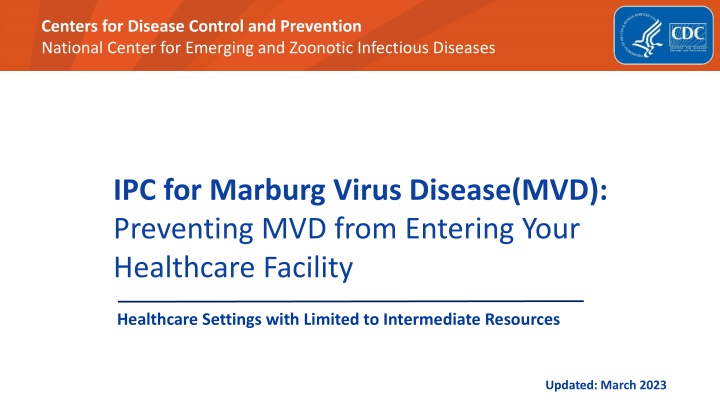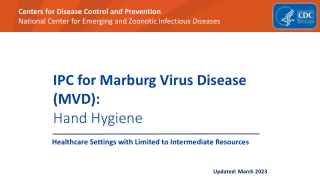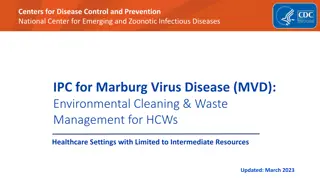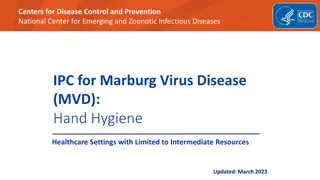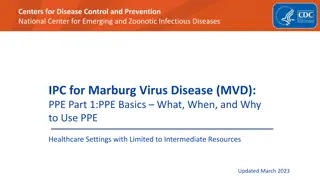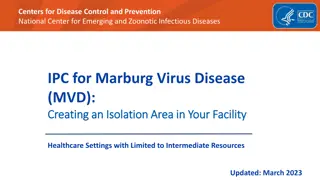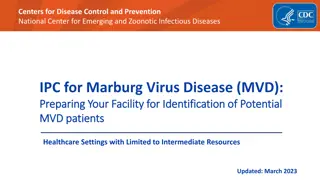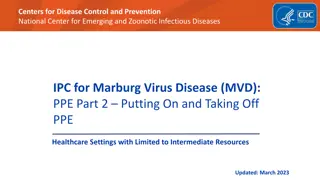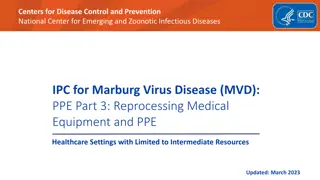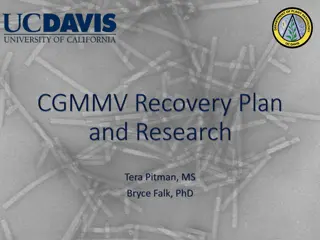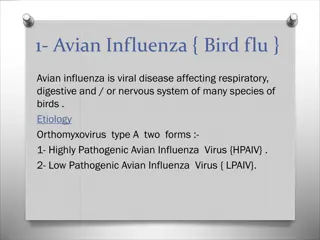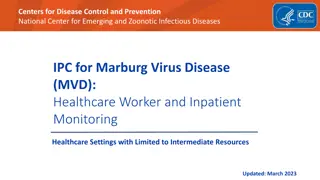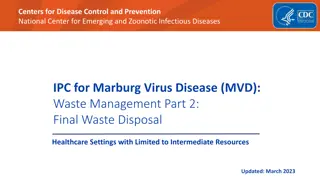Strategies to Prevent Marburg Virus in Healthcare Facilities
Learn the key strategies to prevent Marburg virus disease in healthcare facilities, including identification, isolation, and information dissemination. Early screening and separation of suspected patients are crucial in safeguarding healthcare settings and communities. Comprehensive protocols are in place to ensure prompt action in case of potential exposure.
Download Presentation

Please find below an Image/Link to download the presentation.
The content on the website is provided AS IS for your information and personal use only. It may not be sold, licensed, or shared on other websites without obtaining consent from the author.If you encounter any issues during the download, it is possible that the publisher has removed the file from their server.
You are allowed to download the files provided on this website for personal or commercial use, subject to the condition that they are used lawfully. All files are the property of their respective owners.
The content on the website is provided AS IS for your information and personal use only. It may not be sold, licensed, or shared on other websites without obtaining consent from the author.
E N D
Presentation Transcript
Centers for Disease Control and Prevention National Center for Emerging and Zoonotic Infectious Diseases IPC for Marburg Virus Disease(MVD): Preventing MVD from Entering Your Healthcare Facility Healthcare Settings with Limited to Intermediate Resources Updated: March 2023
Learning Objectives Learning Objectives After this presentation, participants will be able to Name the 3 key strategies to prevent introduction Marburg virus disease into health facilities Explain why screening for Marburg virus disease is important Describe best practices for screening for Marburg virus disease
Discuss Discuss Why is it important to identify people who might have Marburg virus disease before they enter your healthcare facility?
Key Strategies to Prevent Introduction of Key Strategies to Prevent Introduction of Marburg virus disease in Health Facilities: Marburg virus disease in Health Facilities: Identify Isolate Inform
Identify Identify Screening is the process of identifying patients who might be infectious so that they can be promptly isolated and referred for testing and care at a facility intended for that purpose. Screening should take place at the point of entry prior to entering a healthcare facility.
Isolate and Inform Isolate and Inform When a suspect Marburg virus disease patient is identified: Isolate the patient immediately. Explain the situation and next steps to the patient. Inform the designated physician or head nurse Physician or head nurse will verify and ensure isolation measures are in place Physician or head nurse communicates the alert to appropriate phone number
Early identification and separation of suspected Marburg virus disease patients prevents bringing unrecognized Marburg virus disease into your healthcare setting. This protects YOU Your patients Your community
Screening Basics Screening Basics
Key Points for Screening for Key Points for Screening for Marburg Virus Disease Marburg Virus Disease Screen everyone entering a facility Patients, healthcare workers, accompanying family members, etc. Screenbefore any patient care activities. This can be: Upon entrance to a facility (e.g. a main gate) During patient registration (e.g. a registration desk or office) As additional layer, during check-in to wards (e.g. maternity) Always assume that a patient might be infectious and use standard precautions* for ALL patients ALL the time * Infection prevention and control practices are applied to all patients based on the principle that all blood, body fluids, secretion, excretion, nonintact skin, and mucous membrane may contain transmissible infectious agent
Screening Safety Screening Safety Maintain distance (at least 1 meter per WHO recommendation) If at least 1 meter cannot be maintained, wear PPE (gloves, gown, goggles, face mask) Avoid direct face-to-face interaction angle chairs away from each other place plexiglass between screener and person being screened At least 1 meter distance maintained except during temperature check Perform hand hygiene often
Screening Involves Two Parts: Screening Involves Two Parts: Temperature check Questionnaire: signs and symptoms + risk factors in past 21 days
Screening Process Screening Process Example: To keep everyone safe, we are screening for Marburg virus disease. We will take your temperature and ask a few questions. Explain Take Non-contact (infrared) thermometer temperature Use screening tool Follow questions on screening tool (symptoms, exposures) Does the person meet case definition for suspect Marburg virus disease case? If YES, escort to isolation area If NO, they may enter the facility Take action
Non Non- -contact Temperature Check contact Temperature Check Instructions vary for different types/brands of infrared thermometers. Always check the package insert or instructions on the manufacturer s website. 1 Turn on the thermometer Allow 15 minutes for device to warm up (this allows for thermometer to acclimate to the temperature of the environment around it) 2 3 Confirm thermometer has correct settings (e.g., Celsius, body reading instead of object )
Non Non- -contact Temperature Check (continued) contact Temperature Check (continued) Stand to side of person whose temperature is being taken 4 Ask person to push back hair or head scarf, remove hat or glasses, and wipe off perspiration (perspiration in pores can lead to a lower temperature reading) 5 6 Aim for the temple, above the end of the eyebrow (NOT the forehead) Hold thermometer 3-5cm from person s temple (about width of 3 fingers) and press button 7
Non Non- -contact Temperature Check (continued) contact Temperature Check (continued) 8 Read thermometer screen If less than 35 C, take again If 38 C or higher, fever indicated
Screening Algorithm for Screening Algorithm for Marburg Virus Disease Marburg Virus Disease Equatorial Guinea 2023 Equatorial Guinea 2023
Screening Equipment and Supplies Screening Equipment and Supplies Screening stations should have: Print-out of screening algorithm for reference Patient register Infrared (non-contact) thermometer Thermometer batteries/back-up thermometer PPE if distance cannot be maintained
Knowledge Check Knowledge Check Imagine you see your co-worker screening someone entering your facility like this. What suggestions would you give them to help them screen more safely?
Feedback: Screening Feedback: Screening PPE should be based on risk assessment Maintain a distance of at least 1 meter or place barrier such as plexiglass Avoid being face-to-face Point thermometer closer to person s forehead or temple (depending on thermometer instructions)
Reflection Reflection How is the process of screening for Marburg virus disease similar to or different from screening processes you have followed in the past? What challenges have you encountered in the past with screening? If you have never had to participate in screening, what challenges do you imagine you might have?
Key Takeaways Key Takeaways To protect yourself, your patients, and your loved ones Identify Isolate Inform
Thank you! For more information, contact CDC 1-800-CDC-INFO (232-4636) TTY: 1-888-232-6348 www.cdc.gov The findings and conclusions in this report are those of the authors and do not necessarily represent the official position of the Centers for Disease Control and Prevention.
